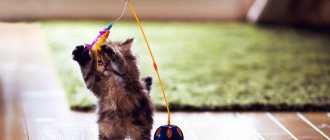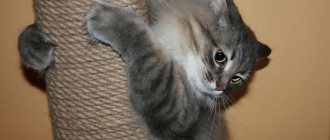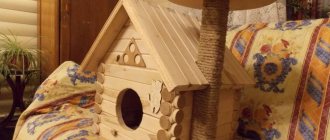A kitten in the house is always a source of joy and positivity, but it is important not to forget that the pet has its own needs. For example, a timely purchased scratching post will not only save furniture and wall coverings from sharp cat claws, but will also certainly please the kitten. In addition, do not forget that you can easily make a device from wood and strong rope yourself.
Making a scratching post
In specialized stores for animals you can find a wide variety of designs for sharpening claws - overhead, corner, in the form of labyrinths or simple columns. But a self-made scratching post has a number of advantages:
- Save money, since a hand-made design will cost several times less than one purchased in a store.
- For manufacturing and decoration, you can take any materials, taking into account what will fit into your interior.
- If you try, you can construct an entire play complex with a variety of columns, shelves and transitions. Such labyrinths are quite difficult to find in the store.
- The design details can be adjusted to the size of the pet. What is presented in specialized stores is produced according to standard sizes and does not always fit the size and age of the animal.
In order to make a regular scratching post, you only need two things - a post and a rope. We'll talk about what rope to use for the scratching post a little later.
How to train a cat to use a scratching post?
The scratching post should be placed near the place in the house where the cat most often scratches the surface. In this case, it is better to cover the surface itself with something to isolate the cat’s access to it. For example, wrap the corners of upholstered furniture with gauze, and cover the walls with panels or stick double-sided tape on them. This is a temporary action. As soon as the cat gets used to the new product, the scratching post should be placed in a place convenient for the owner. Some tips for training a cat:
- If the owner sees that the cat continues to scratch in the wrong place, say loudly “No”, “You can’t” and take the animal to the scratching post.
- Praise your pet if he begins to sharpen his claws on the post on his own.
- Spray the nail clipper with catnip extract. It is sold at the pet store. The smell of mint will arouse your cat's interest.
- Place a piece of your cat's favorite treat near the fight.
What is better not to do:
- Forcibly sit the cat near the scratching post. So the pet may get scared and never approach her again.
- Yell at the cat if he doesn’t want to use the new accessory.
- Place the scratching post in a place that is difficult for the animal to reach.
Types of scratching posts
What kind of scratching post you get as a result depends only on your desire, skills and the amount of time spent on its manufacture. To make the simplest standard structure in the form of a column covered with rope, it will take a maximum of an hour. If you decide to put together an interesting gaming complex for one or several pets, then you will have to work hard and allocate much more time for this.
The simplest version of the play complex consists of several posts and a shelf fixed on top where the pet can rest. The remaining details depend only on your imagination.
How to calculate how much rope is needed for a scratching post?
Now we remember school mathematics and count the amount of rope depending on the length of the pipe. Let's calculate using my example:
- We measure: Pipe diameter 10 cm.
- We multiply: pipe diameter x pi number - i.e. it turns out 10 x 3.14 = 31.4 cm - this is the length of the rope that will be needed for one circle. Taking into account the thickness of the rope, it turns out a little more (for me it was about 38 cm per 1 turn).
- We calculate: The thickness of my sisal rope is 8 mm. It turns out that for about 10 cm of the length of the pipe - 10 circles of rope, since there are small gaps between the circles of rope (here it all depends on the thickness of the rope you take), i.e. 10 x 38 = 380 cm (3.8 m of rope per 10 cm of pipe length).
- Let's calculate: The length of my pipe is 2.3 m. If we assume that there is 1 circle per 1 cm of pipe length, we get 2.3 m per pipe = 230 circles (if the rope is 6 mm thick, there will be more circles): 38 cm (length of rope for 1 lap) x 230 laps (number of laps of pipe) = 8740 cm = 87.4 m of rope for my entire pipe. It took me about that much sisal rope.
It is better to take a rope with a small reserve!
So, wrap the pipe with rope:
I wrapped the end of the rope a little with thread to prevent fraying. We screw the end of the rope to the pipe with a screw and begin to wind it. I will say right away that this is not an easy matter. You need to do it together. One holds the pipe, the other pulls it tightly, and this should be done as tightly as possible to the pipe. After every 10-15 laps, be sure to “compact the rope downwards” with a hammer and screw the rope with a screw (we do this from the side where it will not be visible). If you don't compact the rope properly, it will slide down after a few days.
We attach the corners to which the shelves will be attached to the pipe at the required height, and hide these corners under the rope.
I lined the end of the pipe with fur. When finishing winding the rope, you need to go a little deeper into the fur and secure the rope well with screws.
Step 9. We cut holes in advance for the corners in the shelves and thread the corners that we have on the pipe into them.
Step 10. We secure the pipe well. And enjoy the result!
I made shelves on the wall and the side of the cabinet along its entire height, now the cats have the opportunity to also be on the cabinet. I still had some fur and padding polyester left, so I made a bed and put it on the closet.
Now our cats are exploring their new spaces!
Interesting additions to the gaming complex:
How much rope will be needed?
Any modern rope for a scratching post has a high degree of strength and is resistant to tearing, which makes it an ideal material in this case. Before proceeding with the manufacture or replacement of this element, it is necessary to calculate the length that will be required.
There are two ways to measure footage:
- Using old rope for a scratching post. In this case, you need to remove the rope from the old post, measure its length, or take the rope with you to the store so that the consultant can help you choose the material and footage.
- Calculation using a special formula:
Rope length = (post height/rope diameter) * 3.14 * post diameter.
For example, there is the following data:
- The height of the column is 100 cm, its diameter is 10 cm;
- Rope diameter – 0.8 cm.
From here we get: rope length = (100/0.8) * 3.14 * 10 = 3925 cm, that is, 39.25 m.
The optimal rope diameter is considered to be 8 mm, but 6 mm is quite suitable for making a scratching post.
How much does a cat scratching post cost?
Each buyer has his own main selection criterion. Some people care about quality, others about price, and others about safety. The range of scratching posts is huge, for every taste and budget. The most popular models are columns up to 3000 rubles. List of prices in ascending order (online store, Moscow):
- The cheapest nail polisher costs just over 100 rubles. These are mice, fish or balls wrapped in rope. This toy will become more of an addition and will not replace a cat with a full-fledged scratching post.
- Corrugated cardboard. Prices for such models start from 250 rubles.
- Carpets - from 320 rubles, with impregnation - from 420.
- Jute sharpeners. A simple hanging cylinder with a thin rope costs 450 rubles. A more convenient board costs an average of 600 rubles.
- Sisal. The simplest option will cost 450 rubles, and for a complex made of sisal you will have to pay 14,000.
- The price tag for complexes made of natural oak or pine rises to 27,000, for a three-tier complex made of jute - 10-11 thousand, and the most budget option can be found for 3,000.
The best-selling product in this category is considered to be sisal posts in the price range from 1200-3500 rubles. The second most popular are vertical wall hangings (900-1200 rubles). The top three are closed by floor-mounted double-sided sharpeners made of cardboard (300-800 rubles). A scratching post is as necessary an accessory for domestic cats as a bowl, a bed and a litter box. When getting a cat, you need to include this “cat manicure device” in your list of essential purchases. So, 5 golden rules when choosing a scratching post:
- Safety. There are no sharp corners that could hurt the kitten. Complexes and columns must be stable. The optimal size of the base for a single post is 50x50 cm, and the diameter is at least 10 cm. The mounting for the complexes should be designed for the weight of an adult cat (5 kg on average). Floor mats must have a rubberized base.
- Size and shape. You need to determine where in the apartment the scratch will be located. Is it comfortable for the cat to approach it? Will it fit into the overall interior of the room? The length of the canvas should be 60-70 cm or higher so that the cat can stretch out. The same models are suitable for kittens as for adult cats.
- Material. For the base, natural wood or chipboard is better, and for the winding, natural material: thick rope, cardboard or carpet.
- Care and maintenance. The design should be easy to clean and wash. It would be good if the sharpener elements could be removed and retightened and restored over time.
- Price. Each type has expensive and cheap models. There is plenty to choose from. Domestic models are cheaper than advertised import brands, and are in no way inferior in quality.
Which rope is better to choose?
The choice of ropes is very large, but the main thing you need to pay attention to when choosing is natural fibers. Environmentally friendly materials of natural origin are the best ropes for scratching posts; they are completely safe for both animals and people, are not electrified and will not harm the pet. A cat will definitely like a scratching post coated with natural fiber, which cannot be said about a purchased one made from artificial rope. Some pets may be put off by the synthetic smell, as well as the presence of paint and impregnation.
Polypropylene and nylon ropes are several times stronger than natural ones, but they tend to stretch, and cat's claws can get tangled and stuck in the fibers of the material.
A hemp rope wrap for a scratching post will not last long; the material will quickly fluff due to fragments of fibers.
Which scratching post is better to buy for a kitten?
Experts advise starting with the simplest column. This is a platform on which a stick wrapped with rope is installed.
This format suits most kittens. The column can be immediately taken “for growth.” For a medium breed kitten, the most convenient height is 70 cm. The structure must have a stable base so that during play the scratching post does not fall on the pet and harm it. It is necessary to take into account that the kitten will lean on the post and jump on it. The best first scratching post for a kitten is a simple post with jute rope. As the kitten grows, it develops its own habits. It makes sense to buy a large and expensive complex for cats older than one year. By this time, the owner of the animal will already know how and on what his pet sharpens its claws. Kittens should be taught to use a scratching post from a very early age. The earlier the better. By about one month of age, a kitten's claws become sharp, although they are still soft and weak for scratching walls and other durable surfaces. It is during this period that you need to start using a post or rug. Here the best role model for kittens will be the mother cat. They will begin to repeat after her and gradually get used to using the claw cloth.
Types of ropes
The question of what cat scratching posts are made of worries many owners who have decided to please their pet. There are several of the most common types of rope for a scratching post that can be used to wrap a post:
- Cotton rope. This material looks great and fits perfectly into any interior, but is much more expensive than other types.
- Sisal rope. Its cost is much lower, the structure is fleecy, the material is quite strong, durable with a grayish or pale yellow tint.
- Jute rope. This material is most often used in scratching posts that are sold in stores. Jute rope for scratching posts is the cheapest, but has less strength compared to previous materials.
How much rope do you need?
Currently, any rope product has high strength and resistance to tearing. But before starting work, you need to decide on the length of the rope. There are two measurement methods.
- Use old rope for a scratching post. This means removing the rope completely, measuring it and ordering a similar one in an online store or taking it with you to the store so that the seller can advise you on the best option.
- Calculate using the formula: Rope/rope length = (post height/rope/rope diameter) * 3.14 * post diameter.
What to choose - jute or sisal fiber?
So, both types are popular due to their affordable cost. This factor is quite significant, because winding a post requires several tens of meters of rope. But you should immediately pay special attention to the fact that no matter what material you choose, the scratching post will not last forever! Any thing wears out over time, and this product is no exception. The lifespan of the scratching post depends on the following parameters:
- How often does the pet use it?
- Breed of the animal (large representatives have a much larger nail plate).
- The quality of the scratching post.
Jute is made from the plant of the same name in the mallow family. Its fibers are mainly used in the textile industry, as well as for making ropes and burlap. Features of jute:
- Gray-brown fiber color.
- Softness.
- Smoothness (fibers do not stick out).
- Low cost compared to similar materials.
Sisal rope is much coarser than jute because it is made from raw fibers obtained from the leaves of the agave tree. This plant has unique qualities, which allows it to be used in a wide variety of industries, from food to construction. What features does sisal have?
- Quite a rigid structure.
- Light sandy shade.
- High wear resistance.
Materials for scratching post. Which is better?
When purchasing a scratching post, special attention should be paid to the material from which it is made. This applies to both the frame and the upholstery. Ideally, these should be natural materials. The cat is endowed with a sensitive sense of smell. The strong synthetic smell of fabric can discourage an animal from taking an interest in a new scratching post. She will simply begin to ignore the new thing. For a post or frame base, the following are best suited:
- Natural wood;
- Chipboard, fibreboard;
- Cardboard, although not as strong and durable as wood.
To cover the base, manufacturers use hypoallergenic materials that do not crumble, have no protruding threads and are safe for cats. The most common coatings for scratching posts:
- Jute rope. A natural soft fiber used in the manufacture of bags and ropes. Characterized by low elongation and strength. Not electrified.
- Sisal fabric. A coarse rope with increased wear resistance. Previously, it was used in navigation due to the fact that it did not lose its properties in water. Sisal is made from Agave leaves. When unpainted it has a light yellow color.
- Fabrics: carpet, textiles, velor.
- Cardboard. Relatively recently it has been used in the manufacture of scratching posts. Essentially it is pressed cellulose held together with starch glue. Compared to sisal, it has a short service life - up to 1 year.
Carpet selection
If a cat is accustomed to sharpening its claws on textile surfaces (carpets, furniture), it is necessary to provide it with a worthy alternative. Carpet scratching posts in their texture resemble a material already familiar to a cat. In terms of its composition, carpet for scratching posts can be:
- Fully synthetic: nylon, polyester.
- With an admixture of natural fibers (no more than 20%): linen, cotton, jute, wool.
Synthetic carpet is more durable. It is more often used for cladding. There are differences in the structure:
- Pile carpet, due to its relatively soft texture, is not very suitable for sharpening claws. Even a small pile will not allow you to remove the keratinized layer of the claw.
- Loop carpet copes with this task much better. Cat claws easily penetrate rough loops without getting tangled in them. If the loops become stretched over time, you can simply cut them off. At the same time, this will not spoil the appearance of the scratch.
So, loop synthetic carpet copes better with the role of a scratching post. The simplest model of a carpet scratcher is a rug. It is sold as a separate accessory, or with mounts for installation on a wall or corner of a room. Carpet houses are very popular among buyers. With it, the cat will have the opportunity to sharpen its claws both vertically and horizontally. Often such houses come complete with posts.
Carpet products are available in a wide range of colors. They will become not just a necessary thing for a kitten, but also a decorative element.
Which rope is best to use?
Among the wide variety of materials for covering scratching posts, sisal and jute remain the leaders. Both ropes are environmentally friendly, durable, and safe for the animal. Most manufacturers of pet accessories prefer to work with jute because of its affordable price. A comparison table will help you understand the differences between the two fibers:
| Characteristics | Jute | Sisal |
| Compound | 100% natural, made from the jute plant. | Natural fiber made from Agave leaves |
| Color and texture | From gray to brown. Soft texture without protruding fibers | Sandy light. Hard rope. |
| Price | From 250 rub. | From 500 rub. |
| Lifetime | About 2 years | Up to 3 years |
| Who is it suitable for? | For a kitten or one small pet that does not use the scratching post very actively. | A large cat or several cats. Suitable for AK |
| Advantages | Cheaper than sisal rope, natural, safe. | Long service life, natural fiber, hypoallergenic. |
| Flaws | Not as durable as sisal. | The price is 50% higher than jute. |
Bottom Line: Jute rope is best suited for a kitten, small cat, or less active cat. It is better to take it as the first scratching post. Sisal rope is suitable for owners of several cats, large or overactive pets.
Hemp for scratching post
If you just can’t choose or for some reason don’t want to purchase sisal and jute rope, then you can consider another option for wrapping the scratching post - hemp threads. This material is made from hemp plants, which do not contain narcotic substances. The fibers are used in the production of fabrics and ropes. Although jute and sisal ropes are favored by pet product manufacturers, hemp is just as good, proving that hemp remains an important resource in the industry. New fibers are also mistakenly called hemp - sisal, jute and others. So, let's look at the advantages of hemp threads:
- A variety of colors (the shade can be absolutely any, depending on the processing method).
- Has an average price.
- Its properties are superior to jute rope.
- High strength.
- Resistance to environmental influences.
- High hygroscopic and anti-electrostatic properties.
Sisal for scratching post
Sisal is a fiber consisting of cellulose and lignin, obtained from fresh agave leaves by squeezing without additional processing. The threads are dried in the sun and combed with brushes, and then they are made into ropes, twine, packaging fabrics, washcloths, and mattresses. You can buy sisal for scratching posts rolled into a bundle at a building materials store. Ropes made from this raw material are used in shipping and maritime industries. They are durable, and in terms of strength they are second only to Manila ones. Other properties of sisal products:
- environmentally friendly;
- do not absorb moisture;
- brittle in places of kinks;
- light fibers, rigid structure
- prickly to the touch;
- are more expensive than jute.
Materials for making a scratching post with a bed
- two rectangles made of chipboard or other solid wood material (sizes are selected individually)
- two fiberboard rectangles (same dimensions as chipboard rectangles)
- pipe made of solid material (diameter 80-110 mm)
- rope (cotton, sisal, jute)
- foam rubber
- metal strip (width about 7 cm, length depends on the size of the bed)
- glue
- self-tapping screws
- metal corners
- faux fur or upholstery fabric
Floor scratching posts
There are different floor scratching posts - flat, columns, combined with a bed or a house. They take up a lot of space in the house, but in some cases they are irreplaceable. Flat and heavy floor mounts will help out when the wall material does not allow wall mounts to be attached to them. And you don’t want to constantly trip over light cat rags made of cardboard or fabric that the cat drags around the entire apartment. A floor-mounted claw clipper located under the table will not disturb anyone. The poles will be very good for an active and young cat if there is no place for him to climb in the apartment and there is no way to go outside. Complex complexes with houses and beds will be especially useful where there are several cats and kittens are often born. All animals will have a place to frolic, and they will not constantly get underfoot, scratch and damage furniture.
Flat floor scratching posts
Making a flat, floor-mounted cat scratching post is very easy. To do this, you need to take as a base a piece of wooden board, chipboard or multi-layer plywood 40-50 cm wide and 70-100 cm long. A part from an old cabinet is perfect for this. The base can be wrapped on both sides with carpet with a fabric base, the wrong side out. An old wool rug is ideal for this.
The edges of the carpet must be sewn together with strong threads or fastened together with twine using a crochet hook. This nail sharpener and scratcher at the same time is perfect for a calm, phlegmatic pet. And when one side becomes pretty tattered, you can turn it over. The disadvantage of such a bed comb is that it must be regularly cleaned of wool.
Scratching posts - posts
Claw posts can be made with or without a base. Long posts without a base are attached to the floor and ceiling using metal corners and screws. They can be made from tree trunks 7-10 cm thick with peeled bark or from a plastic pipe with a diameter of 5 cm, tightly wrapped with twine or thin rope in 1 or several layers. Before winding, the pipe must be coated with glue, and the twine, when winding, must be compacted by tapping it with a hammer. But you will need a lot of twine and rope, so a long training post made from a pipe for an active pet will cost a decent amount of money. Making a wooden one is much more profitable.
The column on the base must be made at least 1 m high. A heavy board or multi-layer plywood 40-50 cm wide and 50-70 cm long is required as a base. For the column you will need a piece of thick plastic pipe. The pipe must be attached to the central part of the base using metal corners and screws. Cut a piece of carpet 10 cm wider and longer than the base. In its center, cut a round hole equal to the diameter of the pipe.
Place the cover on the base with the wrong side facing up. The protruding edges of the covering must be folded onto the inside of the base and secured with strong adhesive or a stapler. The pipe must be coated with glue and tightly wrapped with twine or rope. You can insert a soft toy into the hole in the pipe.
With a bed or a house
After learning how to make base posts and flat floor scratching posts with your own hands, step-by-step instructions for creating complexes with beds and houses do not look complicated. If you want to do it with several posts, beds and houses, then you should first make a drawing of the future structure. If there are several cats in the house, then when drawing up the drawing you need to plan the complex so that each animal has its own house or bed. They must be done at the same height, because the animal located below will experience discomfort and may begin to damage the furniture. It is advisable to place posts in a complex for several animals at a distance of at least 60 cm so that the cats do not interfere with each other.
After drawing up a drawing and calculating the amount of necessary materials, you can begin manufacturing the complex step by step:
- Prepare the base for the product. If the building has one post, then the stand is made in the same way as for a post with a base. If the complex is planned with several racks, then the base is cut out.
- Attach the pipe sections to the base using metal corners.
- Make a pattern for the base covering with holes for the pipes. Place the cover on the stand and secure it.
- Wrap the pipes with twine or rope.
- Make beds based on the principle of a flat floor scratching post of such a size that the animals can comfortably sit on them, and attach them to the pipes using furniture corners.
- Attach a house to one of the beds. It must be removable so that it can be washed. It is convenient to fasten it with a zipper, sewing one part of it to the base around the perimeter of the house, and the other to the bed.
It is advisable to attach the completed complex to the floor in the corners so that cats do not turn it over during active games.
Attention, TODAY only!
02.11.2015
The rope wraps around the cat post, making it suitable for grinding down claws. What rope to use for a scratching post is a question asked by those who plan to make the unit with their own hands. For the production of panels and posts, jute rope or sisal rope is used. The materials differ from each other in their consumer properties. The duration of use does not depend on the material and is determined by other factors:
- the size of the cat;
- breed;
- frequency of use of the accessory;
- quality of materials, design features.
How to make a scratching post with a cat bed
Preparation
First you need to determine what size the structure will be for your cat. To determine the size of the bed, estimate how much space your cat occupies when curled up and when lying stretched out. Based on these measurements, select a rectangle of a suitable size from which to cut an oval bed. For the base, select a rectangle of the same size. If the base is smaller, the structure may be unstable and the top will look too massive.
To determine the height of the structure, extend the cat along the wall. The highest point that the cat reaches with its paws from the floor will determine the height of the scratching post. The height can be increased a little, since cats like to stretch out when sharpening their claws. It is not necessary to wrap the bottom of the pipe with rope; the cat will not use it anyway. We will cover the bottom of the pipe with the same fabric as the base.
Types of ropes
Today there are several types of the most common ropes:
- Cotton. The most expensive type of material, it looks beautiful and will fit into any interior.
- Sisal. Lower in cost, durable with a gray-yellow tint.
- Jute rope for scratching post. It is the most popular material for scratching posts. It is the most affordable and durable. With its help you can make designs of the most intricate shapes. It is not as rigid as the previous representative and is not inferior in strength and elasticity.
In the previous articles “Why does a cat need a home” and “Do-it-yourself bed for cats and indoor dogs,” we told you why it is so important for a cat to have its own place in the house, how to choose a house that your pet will appreciate, and described in detail how to make a bed for her . In this article we will continue the topic of creating furniture for our pets with our own hands and tell you how to make a bed with a scratching post at home.










